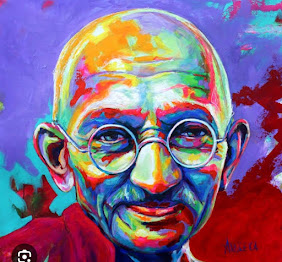India Mahatma Gandhi (மகாத்மா காந்தி) .trademark India.October 2, 1869, the real King
India Mahatma Gandhi
Certainly! Here’s a structured overview of Mahatma Gandhi covering three key topics: his early life and influences, his philosophy of non-violence, and his role in India's independence movement.
1. Early Life and Influences
Mahatma Gandhi, born on October 2, 1869, in Porbandar, India, grew up in a middle-class family with a strong emphasis on education and moral values. His mother, Putlibai, was a significant influence in his early life, instilling in him the principles of non-violence and compassion. As a child, Gandhi was shy and introspective, often facing challenges related to his self-esteem.
In 1888, he traveled to London to study law. This experience exposed him to Western ideas and cultures, but it also deepened his understanding of his own Indian identity. During his time in London, he faced racism and discrimination, which profoundly affected his worldview. After completing his studies, he moved to South Africa in 1893 to work as a legal advisor for an Indian firm.
In South Africa, Gandhi experienced firsthand the harsh realities of racial discrimination. This sparked his interest in civil rights and social justice. His experiences led him to develop the concept of "Satyagraha," or truth-force, which became a cornerstone of his philosophy. He began organizing the Indian community in South Africa to resist oppressive laws through non-violent protest, laying the groundwork for his future activism in India.
 |
2. Philosophy of Non-Violence
Gandhi's philosophy of non-violence, or "Ahimsa," is rooted in the belief that violence breeds more violence and that true strength lies in peaceful resistance. Influenced by various religious and philosophical traditions, including Hinduism, Jainism, and the writings of Leo Tolstoy, Gandhi argued that non-violence is not merely a tactic but a way of life.
He articulated that true non-violence requires immense courage and self-discipline. Gandhi believed that one must be willing to suffer and endure hardships without retaliating, thereby transforming the oppressor through love and understanding. This philosophy resonated with millions and became a powerful tool for social change.
Gandhi's approach was put into practice during various campaigns, such as the Salt March in 1930. This act of civil disobedience protested the British salt tax, drawing attention to the injustices of colonial rule. The Salt March, spanning 240 miles, exemplified Gandhi's method of non-violent resistance, mobilizing thousands to join him in a peaceful demonstration against oppression.
Gandhi also emphasized the importance of self-sufficiency and local production. He promoted the spinning of khadi (homespun cloth) as a means to reject British goods and empower local economies. His ideas on economic independence were intertwined with his vision of political freedom, emphasizing that true independence could only be achieved when Indians took control of their economic destiny.
3. Role in India's Independence Movement
Gandhi returned to India in 1915, and his influence in the independence movement rapidly grew. His leadership during the 1920s and 1930s was marked by a series of campaigns aimed at uniting the Indian populace against British rule. He advocated for the inclusion of marginalized communities, emphasizing the need for a united front against colonialism.
One of Gandhi's significant contributions was the Non-Cooperation Movement launched in 1920, which encouraged Indians to withdraw from British institutions and promote self-governance. Although the movement faced setbacks, including the violent incident at Chauri Chaura in 1922, Gandhi remained committed to his principles, emphasizing the need for non-violent methods.
In 1942, he launched the Quit India Movement, calling for an immediate end to British rule in India. This marked a pivotal moment in the struggle for independence, as it galvanized the nation and showcased the collective will of the people. Despite his imprisonment during this period, Gandhi's resolve only strengthened, and he continued to inspire countless individuals with his vision of a free and just society.
Gandhi’s impact extended beyond the political realm; he emphasized social reform, advocating for the upliftment of the marginalized and promoting communal harmony between Hindus and Muslims. His dedication to eradicating untouchability and fostering unity among diverse groups reflected his commitment to justice and equality.
Gandhi’s assassination on January 30, 1948, by Nathuram Godse was a tragic culmination of his life’s work. However, his legacy endures, inspiring civil rights movements worldwide. Leaders like Martin Luther King Jr. and Nelson Mandela drew on Gandhi's principles of non-violent resistance in their struggles for justice.
Conclusion
Mahatma Gandhi's life and philosophy continue to resonate today, offering a profound example of the power of non-violence in the face of oppression. His dedication to truth, justice, and equality shaped India's struggle for independence and has left an indelible mark on global movements for social change. By advocating for non-violent resistance, Gandhi not only transformed the course of Indian history but also provided a blueprint for future generations seeking to effect change through peaceful means.
Don't share sensitive info. Chats may be reviewed and used to train our models. Learn more
"This Content Sponsored by Genreviews.Online
Genreviews.online is One of the Review Portal Site
Website Link: https://genreviews.online/
Sponsor Content: #genreviews.online, #genreviews, #productreviews, #bestreviews, #reviewportal"

Comments
Post a Comment